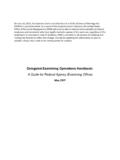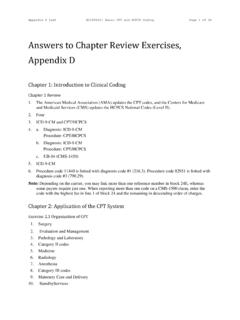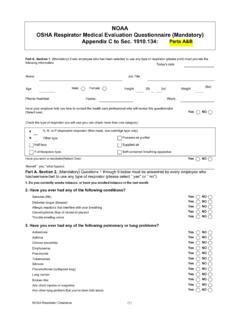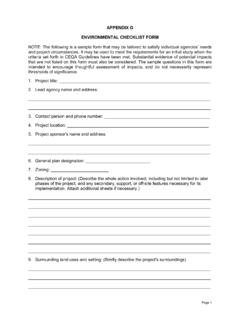Transcription of The Congressional Review Act (CRA): Frequently Asked …
1 The Congressional Review Act (CRA): Frequently Asked Questions Updated November 12, 2021 Congressional Research Service R43992 The Congressional Review Act (CRA): Frequently Asked Questions Congressional Research Service Summary The Congressional Review Act (CRA) is a tool that Congress may use to overturn rules issued by federal agencies. The CRA was included as part of the Small Business Regulatory Enforcement Fairness Act (SBREFA), which was signed into law on March 29, 1996. The CRA requires agencies to report on their rulemaking activities to Congress and provides Congress with a special set of procedures under which to consider legislation to overturn those rules. Under the CRA, before a rule can take effect, an agency must submit a report to each house of Congress and the comptroller general containing a copy of the rule; a concise general statement describing the rule, including whether it is a major rule; and the proposed effective date of the rule.
2 After receiving the report, Members of Congress have specified time periods during which they must submit and act on a joint resolution of disapproval to take advantage of the CRA s special fast track procedures. If both houses pass the resolution, it is sent to the President for signature or veto. If the President were to veto the resolution, Congress could vote to override the veto. If a joint resolution of disapproval is submitted within the CRA-specified deadline, passed by Congress, and signed by the President, the CRA states that the disapproved rule shall not take effect (or continue). The rule would be deemed not to have had any effect at any time, and even provisions that had become effective would be retroactively negated. Furthermore, if a joint resolution of disapproval is enacted, the CRA provides that a rule may not be issued in substantially the same form as the disapproved rule unless it is specifically authorized by a subsequent law.
3 The CRA does not define what would constitute a rule that is substantially the same as a nullified rule. Additionally, the statute prohibits judicial Review of any determination, finding, action, or omission under the CRA. Since its enactment, the CRA has been used to overturn a total of 20 rules: 1 in the 107th Congress (2001-2002), 16 in the 115th Congress (2017-2018), and 3 in the 117th Congress (2021-2022). This report discusses the most Frequently Asked questions received by the Congressional Research Service about the CRA. It addresses questions relating to the applicability of the act, the requirements for submission of rules, the procedural requirements that must be met for Congress to file and act upon a CRA joint resolution of disapproval, and the effects of an enacted CRA joint resolution of disapproval. This report also discusses potential advantages and disadvantages of using the CRA to disapprove rules, as well as other options available to Congress to conduct oversight of agency rulemaking.
4 For further questions not addressed here, please contact Maeve P. Carey (questions regarding history, scope, and agency compliance with the CRA), Christopher M. Davis (questions regarding Congressional procedures and day counts under the CRA), or Valerie C. Brannon (questions regarding legal issues under the CRA). The Congressional Review Act (CRA): Frequently Asked Questions Congressional Research Service Contents Overview of the Congressional Review Act (CRA) .. 1 What Is the CRA?.. 1 What Are Advantages and Disadvantages of Using the CRA?.. 1 How Many Rules Have Been Overturned Using the CRA? .. 6 Definitions Under the CRA .. 6 What Is a Covered Rule Under the CRA? .. 6 Does the CRA Apply to Guidance Documents? .. 7 Does the CRA Apply to Interim Final Rules? .. 8 Does the CRA Apply to Proposed Rules? .. 8 Does the CRA Apply to Executive Orders?.. 9 What Is a Major Rule Under the CRA? .. 9 What Happens When a Rule Is Designated as Major?
5 10 Who Determines Whether a Rule Is Major?.. 11 Does the CRA Apply to Non-Major Rules?.. 11 Agency Submission of Rules .. 12 When Does an Agency Have to Submit a Rule to Congress and GAO? .. 12 How Do I Check If a Rule Has Been Submitted Under the CRA?.. 12 What Happens If an Agency Does Not Submit a Rule to Congress?.. 12 Congressional Procedures Under the CRA .. 14 How Do I Introduce a Joint Resolution of Disapproval?.. 14 Can a Joint Resolution of Disapproval Contain a Preamble?.. 15 How Is a Joint Resolution of Disapproval Different from a Bill?.. 15 Can a Joint Resolution of Disapproval Be Used to Invalidate Part of a Rule or More Than One Rule? .. 15 What Are the CRA Fast Track Procedures? .. 15 What Are the CRA Fast Track Procedures for Senate Committee Consideration? .. 16 What Are the CRA Fast Track Procedures for Senate Floor Consideration? .. 16 For How Long Are the Fast Track Procedures Available?
6 17 Do Disapproval Resolutions Have to Be Submitted in Both Chambers of Congress? .. 17 What Happens If Congress Adjourns Before the CRA Initiation or Action Periods Conclude?.. 18 Is It Possible to Ascertain When the Periods for Submission, Discharge, and Action on a Resolution to Disapprove a Given Rule Begin and End?.. 18 Effect of a Resolution of Disapproval .. 18 What Is the Effect of Enacting a CRA Joint Resolution of Disapproval?.. 18 When Is a New Rule Substantially the Same as a Disapproved Rule? .. 19 How Is the Substantially the Same Prohibition Enforced? .. 21 What Is the Effect of a CRA Joint Resolution Disapproving an Amendment to a Previously Issued Rule? .. 22 What Is the Effect of a CRA Joint Resolution Disapproving a Rule that Repeals a Previous Rule? .. 22 What Happens If a Rule That Is Already Effective Is Overturned?.. 23 Is There Judicial Review Under the CRA? .. 23 The Congressional Review Act (CRA): Frequently Asked Questions Congressional Research Service What Other Tools Are Available to Congress for Conducting Oversight of Federal Regulations?
7 26 Appendixes appendix A. Rules Overturned Using the Congressional Review Act .. 28 appendix B. Government Accountability Office (GAO) Opinions on Whether Certain Agency Actions Are Rules Under the 30 Contacts Author Information .. 33 The Congressional Review Act (CRA): Frequently Asked Questions Congressional Research Service 1 Overview of the Congressional Review Act (CRA) What Is the CRA? The Congressional Review Act (CRA) is a tool that Congress may use to pass legislation overturning a rule issued by a federal agency. When Congress passes a law, it often grants rulemaking authority to federal agencies to implement provisions of the law. That delegation of rulemaking authority, and the rules issued by federal agencies under this authority, is a crucial component of the policymaking process. Congress has an interest in ensuring that federal agencies, when issuing rules, are faithful to Congressional intent.
8 To conduct oversight of federal agency actions, Congress has a number of tools available, including the The CRA was enacted in 1996 as part of the Small Business Regulatory Enforcement Fairness Under the CRA, before a rule can take effect, an agency must submit the rule to Congress and the Government Accountability Office (GAO).3 Upon receipt of the rule by Congress, Members of Congress have a specified time period during which to submit and take action on a joint resolution of disapproval overturning the rule. If both houses pass the joint resolution, it is sent to the President for signature or veto. If the President were to veto the joint resolution, Congress could vote to override the veto. Enactment of the joint resolution would take the rule out of effect or prevent it from going into effect, and the agency would be prohibited from issuing a rule that is substantially the same without further authorization from What Are Advantages and Disadvantages of Using the CRA?
9 The CRA contains several notable features that could be seen as advantages and/or disadvantages to disapproving rules using the CRA, rather than through regular legislation. Procedural The most notable feature of the CRA is its special set of parliamentary procedures for considering a joint resolution disapproving an agency s final rule. These procedures make it easier for Congress to pass a joint resolution of disapproval, particularly in the Senate. Perhaps most significantly, when a joint resolution of disapproval meets certain criteria, it cannot be filibustered in the Senate. In addition, when 20 calendar days have elapsed after the receipt and publication of a rule, a petition, signed by 30 Senators, can be presented on the floor to discharge a Senate committee of the further consideration of a disapproval Once the committee is discharged, any Senator can make a nondebatable motion to proceed to consider the disapproval resolution.
10 Should a majority of the Senate vote to consider the disapproval resolution, debate on it is limited, and a final vote would be all but Not all of the CRA s procedures are advantageous, however a joint resolution of disapproval may still face some procedural challenges. First, one might argue that the likelihood of a 1 For a broader discussion of Congress s oversight tools, see CRS Report RL30240, Congressional Oversight Manual; and CRS Report R45442, Congress s Authority to Influence and Control Executive Branch Agencies, by T odd Garvey and Daniel J. Sheffner. 2 T it le II, Subt it le E, P .L. 104-121, 5 601 et seq. 3 5 801(a)(1)(A). 4 5 801(b)(2). 5 5 802(c). 6 5 802(d). The Congressional Review Act (CRA): Frequently Asked Questions Congressional Research Service 2 presidential veto (discussed in detail below) means that most CRA disapproval resolutions are likely to be subject to a de facto supermajority requirement.
















